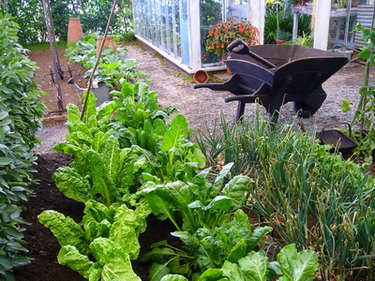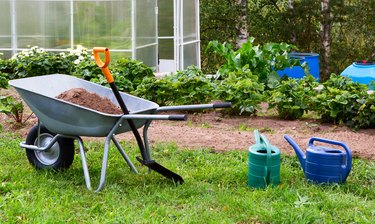
The wheelbarrow is a simple gardening tool that is still highly effective in this technological world. While mowers have gotten fancier, and hand edging clippers have morphed into weed whackers, the wheelbarrow design has changed little over the centuries. With its ability to haul mulch, yard waste, new plants and compost, there are numerous uses of wheelbarrows, most homeowners will say.
Uses of Wheelbarrows
Video of the Day
Most people think of wheelbarrows in relation to yard work. And there's good reason for that. Homeowners find that the wheelbarrow is a very useful gardening tool. But construction companies use wheelbarrows to move sand, dirt, and other heavy materials. They can be used for hauling away scrap and debris or rubble left at a construction site. Wheelbarrows are also good for mixing concrete.
Video of the Day
Professional landscapers use wheelbarrows to move soil, gravel, mulch and fertilizer. They're great for hauling new plants and even small trees around a yard. Wheelbarrows can lug quantities of stones or bricks. There are different types of wheelbarrows for different jobs.
In the yard, wheelbarrow uses are many. The wheelbarrow is the best way to carry mulch from the pile of delivered by the garden center. Or, you can use it to haul the heavy bags of mulch you brought home. You can use it to transport compost from your compost bin to your garden. When weeding, simply pile them into the wheelbarrow before putting them into yard waste bags. If you have a woodpile, one of the uses of a wheelbarrow is to transport the wood.
Types of Wheelbarrows

Wheelbarrows come in many types, from the small home wheelbarrow to the commercial grade wheelbarrow. A wheelbarrow works because it has a wheel and an axle to hold the wheel, along with a specially-shaped lever that distributes the load to make it easier to carry heavy loads.
Today, wheelbarrows are usually made of plastic or steel. Plastic is lightweight, while steel is more durable. But store a steel wheelbarrow out of the elements so it doesn't rust. Plastic won't rust, but it may crack in the cold or under a heavy load. If you have a very small yard and garden, you may be able to use a foldable canvas option.
Most wheelbarrows have two wooden handles that are easy to grip, although there are one-handled versions that may work better for people with narrow shoulders. Wheelbarrows also come with one or two wheels. One wheel, with its tripod design, is easier to move and dump, but two wheels allows you to carry heavier loads. The downside is that two-wheeled versions are heavier, less maneuverable and don't work well on hills.
The Evolution of the Wheelbarrow

Today's wheelbarrow has its roots in a wooden wheel cart invented in China around 231 A.D. It was used to carry food and supplies into battle and move injured soldiers off the battlefield. By the 12th to 13th century, the wheelbarrow was being used in Europe to distribute fertilizer.
The same ingenuity that brought about the wheelbarrow continues today. For years, wheelbarrows had a wheel with an inner tube, like those for bike and car tires. But, tire tubes can lose air, or a sharp object can pop the tube and cause it to flat. Now there are wheelbarrow tires made of solid rubber, which don't go flat. But they also don't absorb shock very well. Other tires are made with a mixture of rubber and air, which are better shock absorbers.
There are even wheelbarrows today that come with snowplow attachments for small snowplow jobs. Some wheelbarrows can double as a dolly for moving boxes and furniture, and come with attachments that can organize tools, materials and hardware.